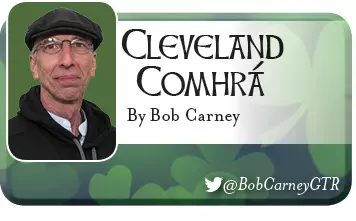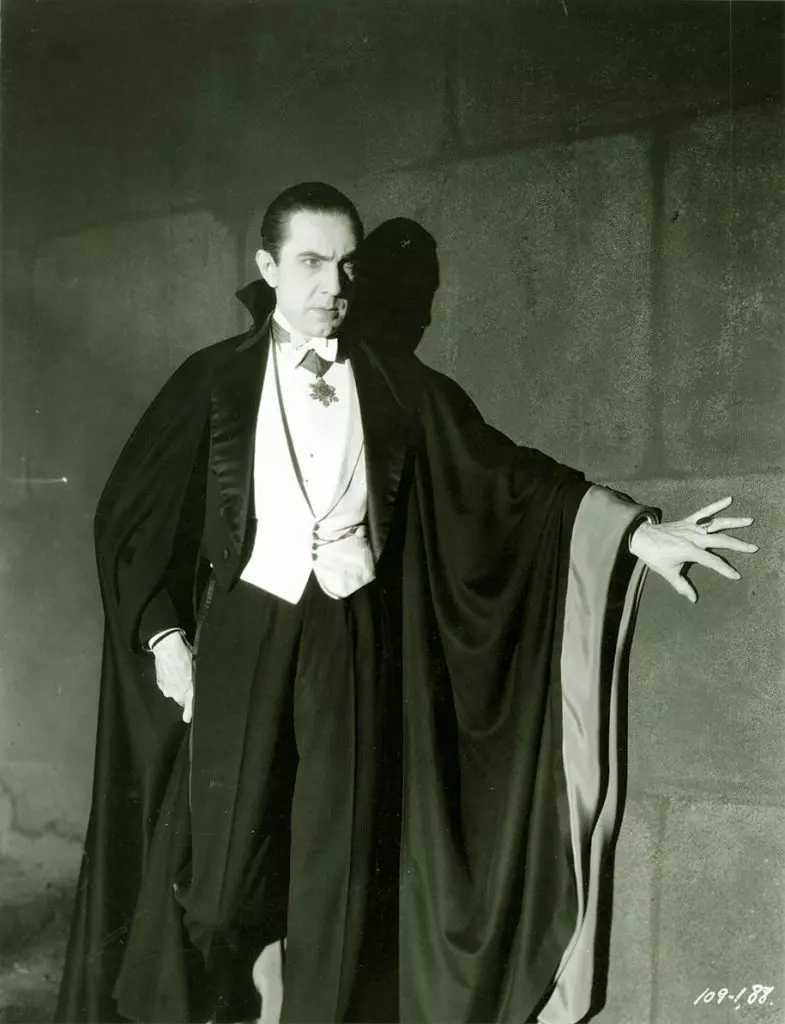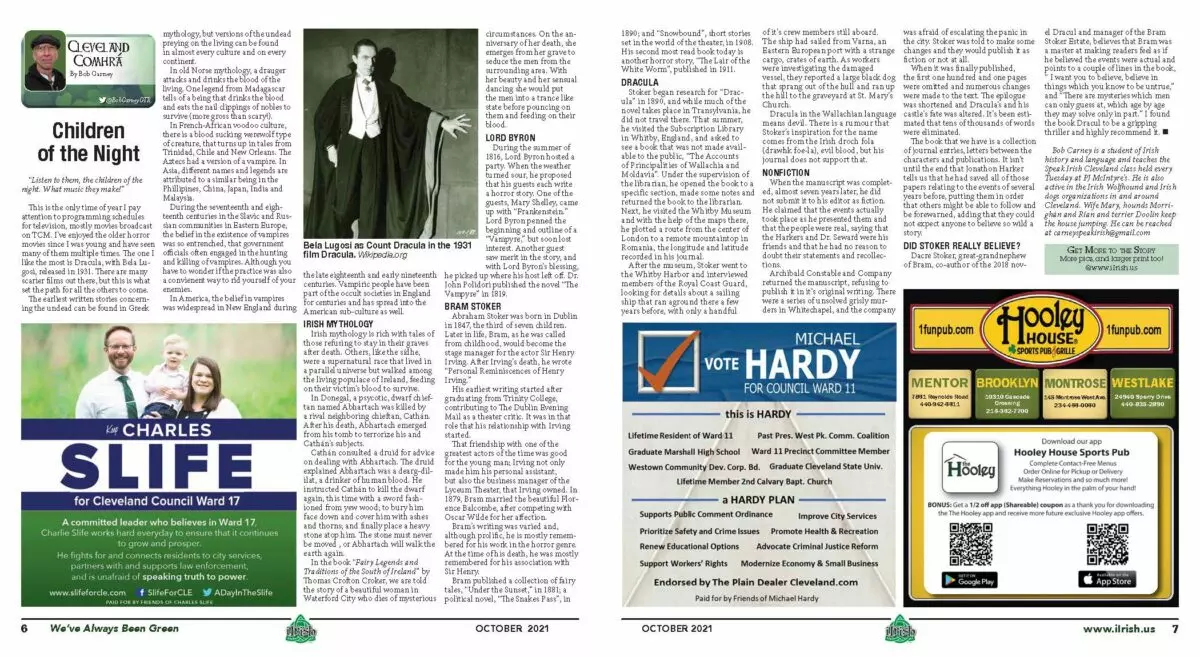Cleveland Comhrá: Children of the Night
- John O'Brien
- September 27, 2021
- Edited 4 months ago
Table of Contents

Cleveland Comhrá: Children of the Night
By Bob Carney
“Listen to them, the children of the night.
What music they make!”
This is the only time of year I pay attention to programming schedules for television, mostly movies broadcast on TCM. I’ve enjoyed the older horror movies since I was young and have seen many of them multiple times. The one I like the most is Dracula, with Bela Lugosi, released in 1931. There are many scarier films out there, but this is what set the path for all the others to come.
The earliest written stories concerning the undead can be found in Greek mythology, but versions of the undead preying on the living can be found in almost every culture and on every continent.
In old Norse mythology, a drauger attacks and drinks the blood of the living. One legend from Madagascar tells of a being that drinks the blood and eats the nail clippings of nobles to survive (more gross than scary!).
In French-African voodoo culture, there is a blood sucking werewolf type of creature, that turns up in tales from Trinidad, Chile and New Orleans. The Aztecs had a version of a vampire. In Asia, different names and legends are attributed to a similar being in the Phillipines, China, Japan, India and Malaysia.
During the seventeenth and eighteenth centuries in the Slavic and Russian communities in Eastern Europe, the belief in the existence of vampires was so entrenched, that government officials often engaged in the hunting and killing of vampires. Although you have to wonder if the practice was also a convienent way to rid yourself of your enemies.
In America, the belief in vampires was widespread in New England during the late eighteenth and early nineteenth centuries. Vampiric people have been part of the occult societies in England for centuries and has spread into the American sub-culture as well.
Irish Mythology
Irish mythology is rich with tales of those refusing to stay in their graves after death. Others, like the sídhe, were a supernatural race that lived in a parallel universe but walked among the living populace of Ireland, feeding on their victim’s blood to survive.
In Donegal, a psycotic, dwarf chieftan named Abhartach was killed by a rival neighboring chieftan, Cathán. After his death, Abhartach emerged from his tomb to terrorize his and Cathán’s subjects.
Cathán consulted a druid for advice on dealing with Abhartach. The druid explained Abhartach was a dearg-dililat, a drinker of human blood. He instructed Cathán to kill the dwarf again, this time with a sword fashioned from yew wood; to bury him face down and cover him with ashes and thorns; and finally place a heavy stone atop him. The stone must never be moved , or Abhartach will walk the earth again.
In the book “Fairy Legends and Traditions of the South of Ireland” by Thomas Crofton Croker, we are told the story of a beautiful woman in Waterford City who dies of mysterious circumstances. On the anniversary of her death, she emerges from her grave to seduce the men from the surrounding area. With her beauty and her sensual dancing she would put the men into a trance like state before pouncing on them and feeding on their blood.
Lord Byron
During the summer of 1816, Lord Byron hosted a party. When the weather turned sour, he proposed that his guests each write a horror story. One of the guests, Mary Shelley, came up with “Frankenstein.” Lord Byron penned the beginning and outline of a “Vampyre,” but soon lost interest. Another guest saw merit in the story, and with Lord Byron’s blessing, he picked up where his host left off. Dr. John Polidori published the novel “The Vampyre” in 1819.
Bram Stoker
Abraham Stoker was born in Dublin in 1847, the third of seven children. Later in life, Bram, as he was called from childhood, would become the stage manager for the actor Sir Henry Irving. After Irving’s death, he wrote “Personal Reminiscences of Henry Irving.”
His earliest writing started after graduating from Trinity College, contributing to The Dublin Evening Mail as a theater critic. It was in that role that his relationship with Irving started.
That friendship with one of the greatest actors of the time was good for the young man; Irving not only made him his personal assistant, but also the business manager of the Lyceum Theater, that Irving owned. In 1879, Bram married the beautiful Florence Balcombe, after competing with Oscar Wilde for her affection.
Bram’s writing was varied and, although prolific, he is mostly remembered for his work in the horror genre. At the time of his death, he was mostly remembered for his association with Sir Henry.
Bram published a collection of fairy tales, “Under the Sunset,” in 1881; a political novel, “The Snakes Pass”, in 1890; and “Snowbound”, short stories set in the world of the theater, in 1908. His second most read book today is another horror story, “The Lair of the White Worm”, published in 1911.
Dracula
Stoker began research for “Dracula” in 1890, and while much of the novel takes place in Transylvania, he did not travel there. That summer, he visited the Subscription Library in Whitby, England, and asked to see a book that was not made available to the public, “The Accounts of Principalities of Wallachia and Moldavia”. Under the supervision of the librarian, he opened the book to a specific section, made some notes and returned the book to the librarian. Next, he visited the Whitby Museum and with the help of the maps there, he plotted a route from the center of London to a remote mountaintop in Romania, the longitude and latitude recorded in his journal.

After the museum, Stoker went to the Whitby Harbor and interviewed members of the Royal Coast Guard, looking for details about a sailing ship that ran aground there a few years before, with only a handful of it’s crew members still aboard. The ship had sailed from Varna, an Eastern European port with a strange cargo, crates of earth. As workers were investigating the damaged vessel, they reported a large black dog that sprang out of the hull and ran up the hill to the graveyard at St. Mary’s Church.
Dracula in the Wallachian language means devil. There is a rumour that Stoker’s inspiration for the name comes from the Irish droch fola (drawhk foe-la), evil blood, but his journal does not support that.
Nonfiction
When the manuscript was completed, almost seven years later, he did not submit it to his editor as fiction. He claimed that the events actually took place as he presented them and that the people were real, saying that the Harkers and Dr. Seward were his friends and that he had no reason to doubt their statements and recollections.
Archibald Constable and Company returned the manuscript, refusing to publish it in it’s original writing. There were a series of unsolved grisly murders in Whitechapel, and the company was afraid of escalating the panic in the city. Stoker was told to make some changes and they would publish it as fiction or not at all.
When it was finally published, the first one hundred and one pages were omitted and numerous changes were made to the text. The epilogue was shortened and Dracula’s and his castle’s fate was altered. It’s been estimated that tens of thousands of words were eliminated.
The book that we have is a collection of journal entries, letters between the characters and publications. It isn’t until the end that Jonathon Harker tells us that he had saved all of those papers relating to the events of several years before, putting them in order that others might be able to follow and be forewarned, adding that they could not expect anyone to believe so wild a story.
Did Stoker Really Believe?
Dacre Stoker, great-grandnephew of Bram, co-author of the 2018 novel Dracul and manager of the Bram Stoker Estate, believes that Bram was a master at making readers feel as if he believed the events were actual and points to a couple of lines in the book, “ I want you to believe, believe in things which you know to be untrue,” and “There are mysteries which men can only guess at, which age by age they may solve only in part.” I found the book Dracul to be a gripping thriller and highly recommend it.
*Bob Carney is a student of Irish history and language and teaches the Speak Irish Cleveland class held every Tuesday at PJ McIntyre’s. He is also active in the Irish Wolfhound and Irish dogs organizations in and around Cleveland. Wife Mary, hounds Morrighán and Rían and terrier Doolin keep the house jumping. He can be reached at [email protected]





